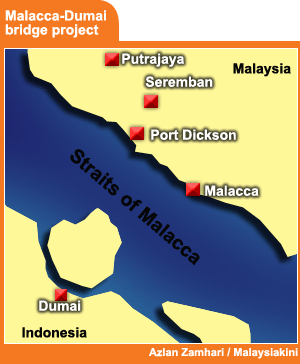KINIBIZ Economists are questioning the economic viability of building a bridge from Teluk Gong in Malacca with the port of Dumai in Sumatra across the Straits of Malacca, after it emerged that the plan which was first mooted in 1995, could be revived.
 “While there is no specific feasibility studies to reference, available data in terms of population size, economic capacity of the Indonesian people in the Dumai area and the prospect of substantial capital investment, makes the project’s viability quite questionable,” said RAM Holdings group chief economist Yeah Kim Leng.
“While there is no specific feasibility studies to reference, available data in terms of population size, economic capacity of the Indonesian people in the Dumai area and the prospect of substantial capital investment, makes the project’s viability quite questionable,” said RAM Holdings group chief economist Yeah Kim Leng.
The project was first suggested in the mid-nineties, under then prime minister Dr Mathathir Mohamad, but shelved when the Asian Financial Crises hit. In the later years of the 2000s, the project came up every once in awhile; in 2006 and again in 2009 then Malacca chief minister Ali Rustam broached the subject, but again it never took off.
It is estimated that the 48km plus bridge from Teluk Gong in Malacca to Pulau Rupat (the closest connecting point) will cost approximately RM44.3 billion, and at this length is will be the longest sea crossing in the world. From there, a 71.2km highway across Pulau Rupat will connect the bridge with the port city of Dumai.
Yeah highlighted that funding the project will be a major issue, as either public or private investment will come with its own set of concerns.
Although the Export-Import Bank of China (EXIM), have indicated in the past that it would be willing to invest substantially in the project, Yeah says that the are still long-term cost issues. He notes “even if the EXIM bank funded the project, there is the issue of repayment, which will be substantial ... is there really a sufficient amount of traffic to be able to pay it off and at what rate (toll rate)? ... it is likely that the governments will have to step in to top it up (repayment costs).”
In the event, that the government decides to fund the project, then the question shifts to the multiplier effects to make it worthwhile, said Yeah. He questions if there are better projects to spend the money on, especially in view of the government’s recent announcements that it will be sequencing mega projects, to prioritise those with high multiplier effects and low import content.
Go to KiniBiz for more.

